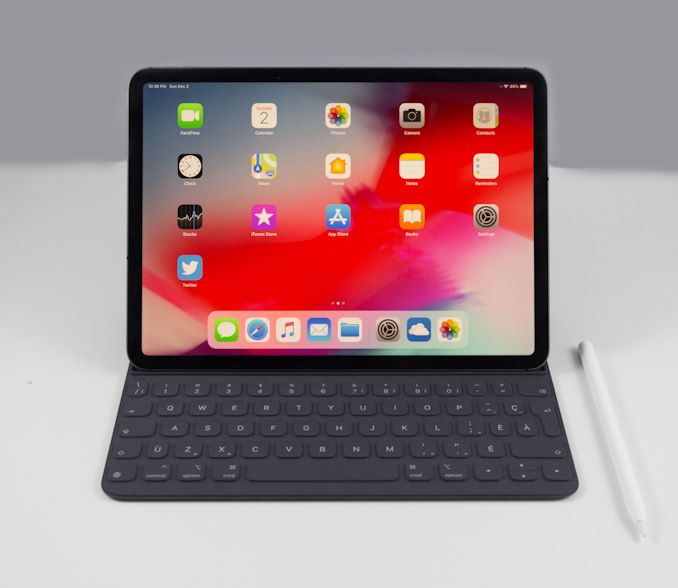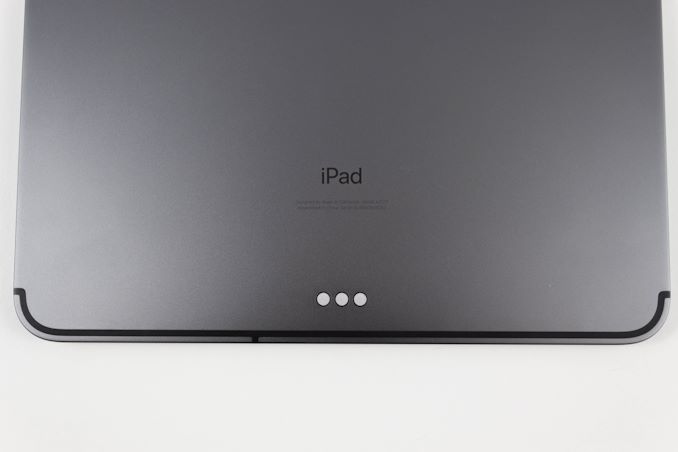The 2018 Apple iPad Pro (11-Inch) Review: Doubling Down On Performance
by Brett Howse & Andrei Frumusanu on December 4, 2018 10:00 AM ESTFinal Words
Apple calls the 2018 iPad Pro the iPad they’ve always dreamed of building. The new iPad Pro offers a completely new design, with some great new features, so it’s not difficult to see why they say that. The first thing anyone will notice is the new thinner bezels, offering up a modern take on the iPad idea.
Let’s start with the display, since it is really a highlight of this iPad. The performance of it is simply outstanding, and Apple offers arguably the best display in any consumer device with the iPad Pro. The 120 Hz ProMotion makes scrolling incredibly smooth. The True Tone adjustment brings a pleasant look to the display in any lighting condition. And the color accuracy is pretty much second to none. Really the only thing missing is HDR – and the battery life hit that would entail in such a portable device would probably not be worth it.
Apple’s SoC efforts have been leading the industry, and the A12X in the iPad Pro offers plenty of performance, but without breaking the power budget. With four Vortex cores for performance, coupled with four Tempest cores for efficiency, and all eight cores available all the time, you get both the burst performance needed for everyday workloads, along with the incredible battery life you’d expect in a tablet. On the GPU side, the seven GPU cores offer 75% more GPU hardware than the iPhone XS, and more memory bandwidth as well. The GPU and CPU both share the sameLPDDR4X memory, with up to 6 GB, and the performance is excellent.
Apple’s new Pencil is also a nice improvement over the outgoing model. A small thing like one flat side makes the Pencil not roll away on you, and also doubles as a connection to the iPad Pro where it magnetically docks for charging. It is a much-improved design over the original, and it is double improved by having a capacitive button on near the tip which can do various functions depending on the application being used.
The new Smart Folio Keyboard is also a nice improvement, offering a much easier setup, but it is not as clear of a win as the Pencil. The extra slot for a second position is nice, but it makes the iPad a bit wobbly and unstable if used anywhere but a nice, flat desk. The keys also don’t offer backlighting, and the definitely should for the price. iOS also shows from time to time that it was not originally intended to be used with a keyboard, which can be frustrating.
And while the hardware is fantastic, iOS is starting to feel like it is holding back the iPad Pro in the productivity realm. There is a lot of performance on tap, but getting access to it can be difficult. It really comes down to the app developers to pull the performance out of this iPad, but due to the fragmented iPad market, they may just target the lowest common denominator, which is often the case. A game like Civilization VI comes by default running at a very low resolution so that it will work well with the older iPads Pros, and will take a developer update to unlock any more fidelity, since the end user has no control over that on iOS for the most part. It makes it easy, but it isn’t always the best experience.
At least on an app basis, the silver lining here is that Adobe bringing their Creative Cloud suite to the iPad is definitely a big win for Apple. Done well, and it should showcase the performance of the tablet, along with the Pencil, in ways that many other apps won’t take advantage of.
If you are a fan of iOS, and you have a workflow that is suited to its operation, there’s little doubt the new iPad Pro models are going to be a great addition, but considering the price increase over the base iPad, you really have to need that performance to justify the iPad Pro 11-inch. Apple also charges a pretty hefty sum to upgrade the internal storage, and the accessories really add on to the price tag as well.
With all of that said, there’s no doubt in my mind that the latest iPad Pro is the best iPad ever. It’s the fastest. It offers great battery life. The display is second to none. But it is still, at its nature, an iPad. Apple has been working on the productivity angle for a few generations now, and while this is their best stab at it yet, the iPad Pro is still in that awkward gap between a content consumption device and a traditional laptop or the Windows convertibles that the original iPad inspired. What you get then is a device that's certainly a lot more professional than the base iPad and a lot more useful for productivity use cases, but also something that feels more like a larger, more expensive iPad than the kind of top-tier machines the iPad Pro is intended to compete with.













145 Comments
View All Comments
jeremyshaw - Tuesday, December 4, 2018 - link
Crikey, that's a fast chip.That question about the xbox one s class GPU does raise questions. Why does the Xbox One S draw so much power?
axfelix - Tuesday, December 4, 2018 - link
Because it's still using an AMD GPU architecture from 2013, and Apple's and Nvidia's architectures are >3x as powerful per watt at this point.PeachNCream - Tuesday, December 4, 2018 - link
Eh, NV is just as bad. Their current gen products (GT 1030 aside) generally need more than 75W of power and occupy space equal to two PCI-E slots.Pyrate2142 - Tuesday, December 4, 2018 - link
Yeah, but those 75W and above cards are operating at a significantly higher performance. You cannot really compare it straight like rust, because 1- not only is the NV cards doing full FP32 compute compared to mixed FP16 and FP32 on the iPad, meaning it is inherently a more strenuous workload to begin with. 2- performance scaling is not a linear functionIn short we can't really take those claims at face value because A- we don't have a way to measure and compare performance in the first place (which brings me to the question of how is apple actually comparing? Using TFLOP performance? Because TFLOP is not an accurate way of measuring GPU performance as a GPU has to do more than just FLOP. Take a RX580 at almost 7 TFLOP and a similar GTX1060 6GB at 4.5TFLOP in FP32. The TFLOP difference suggests a huge performance differences butcher they both perform similarly.) and B- again NV doesn't really make cards that scale down to what the iPad is having. In short, best case it's truly an apples to oranges comparison and I don't think you can directly translate that GPU in the A12X performance against AND or NV because it just not the same comparison both in power target of even how the performance is measured
Spunjji - Wednesday, December 5, 2018 - link
Just responding firstly to endorse your comment, and secondly to note that Nvidia do make something at that scale - the 256 CUDA-core Pascal GPU in Tegra X2 would be a solid point of comparison, were it not basically impossible to perform one.olde94 - Wednesday, December 5, 2018 - link
For power/performance i have a few inputs.When looking at Nvidia jetsons running X2 and X1 most performance improvement are on the CPU side of things.
Also for power refference. The Nvidia shield is not a portable device, and the nintendo switch, running the older version of the 256 cuda core SoC have the GPU running at 764mhz in docked mode and 324 in handheld. The reason is a combination of the battery and the active 30mm fan + somewhat heatsink, cooling solution. The charger is 40W charger, and while it does charge the battery, i will assure you no more than 15W is used for this, and based on charging time during full load, it's less than 10W. Note also that the screen is NOT on.
An nvidia TX2 is rated at ~20W if i recall, making it WAY more power hungy than the A12 chip
PeachNCream - Thursday, December 6, 2018 - link
Eh, the A12X puts a lot into perspective when it comes to compute performance. The big three players in the x86 CPU and GPU space are chasing performance at a cost of rising TDP, at least the phone and tablet competition is highly constrained by power and thermal limits inherent to the platform. The result is that the technological improvements we see in those highly mobile products generally focus on both power and performance. Its a pity to see stupid dual slot coolers on graphics cards to that have to cope with TDPs that range from 75 to an absolutely irrational 200+ watts and processors that blow their TDP budget by 50% under load. I had a Packard Bell 386 PC that was happy with a 60W internal power supply. Computers in 2018 are stupid. They shouldn't even need cooling fans at this point or heatsinks. That old Packard Bell ran a bare IC without even so much as a piece of metal glued atop it and under load, you could rest your thumb on the CPU and it would feel warm, but not hot to the touch.Oliseo - Thursday, January 2, 2020 - link
That old packard bell was orders of magnitude slower than modern CPU/GPU's and was orders of magnitude less effecient than modern CPU/GPU's.Even if you normalised for cooling requirements.
This doesn't make modern CPU's/GPU's stupid, you know what it does make stupid tho....
tipoo - Tuesday, December 4, 2018 - link
It's several fabrication node shrinks back (28nm vs 7nm) and on a 2013 architecture.You could probably get something close-ish to XBO performance in a handheld Xbox on 7nm, that would be an interesting product if it had full compatibility...
axfelix - Tuesday, December 4, 2018 - link
The Xbox One S (which I think is the comparison here) is actually on 16nm, though it's still that 2013 architecture. I think Apple gets about 2/3 of the advantage from the architecture and 1/3 from the process, and it does work out still to >3x efficiency.